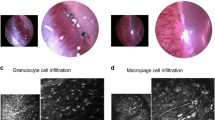Abstract
Vasculogenesis, angiogenesis and vascular remodelling are complex processes where the fate of several cell types is determined by different signalling networks. Many of these networks ultimately function by changing the abundance of RNA transcripts within the cells which constitute blood vessel walls. Researchers can now map these transcript abundance changes using gene array technology. In this review, we describe the design, production and use of a gene array specifically tailored to investigate vascular biology. We describe the advantages of tailored gene arrays, and give detailed protocols based on our experience to allow the reader to use such gene arrays to generate meaningful data. We list the issues to consider when choosing and verifying the genes and splice variants included in an array, and describe our use of Arabidopsis sp. RNA spikes for quality control. We present data that illustrates the absolute necessity for both technical and biological replicates to be incorporated in the design of gene array experiments using primary cells such as HUVECS. Finally, we describe methods for the normalisation and interpretation of the data that gene arrays produce. The approach to gene array technology described here is easily within reach of the budget and expertise of most academic research groups.
Similar content being viewed by others
References
Folkman J, D'Amore PA. Blood vessel formation: What is its molecular basis? Cell 1996; 87: 1153–55.
Hanahan D, Folkman J. Patterns and emerging mechanisms of the angiogeneic switch during tumorigenesis. Cell 1996; 86: 353–64.
Risau W. Mechanisms of angiogenesis. Nature 1997; 386: 671–4.
Lipshutz R, Fodor S, Gingeras TR, Lockhart DJ. High density synthetic oligonucleotide arrays. Nat Genet Sup 1999; 21: 20–4.
Lockhart DJ, Dong H, Byrne MC et al. Expression monitoring by hybridisation to high density oligonucleotide arrays. Nat Biotechnol 1996; 14(1112): 1675–80.
Adessi C, Matton G, Ayala G et al. Solid phase DNA amplification: Characterisation of primer attachment and amplification mechanisms. Nucleic Acids Res 2000; 28(20e87): 1–8.
Borthwick JM, Charnock-Jones DS, Tom BD et al. Determination of the transcript profile of human endometrium. Mol Hum Reprod 2003; 9(1): 19–33.
Sargent TD, David IB. Differential gene expression in the gastula of Xenopus Laevis. Science 1983; 222(4620): 135–9.
Duggan D, Bittner M, Chen Y et al. Expression profiling using cDNA microarrays. Nat Genet Sup 1999; 21: 10–4.
Clark DE, Smith SK, He Y et al. A vascular endothelial growth factor antagonist is produced by the human placenta and released into the maternal circulation. Biol Reprod 1998; 59: 1540–48.
Sowter HM, Corps AN, Evans AL et al. Expression and localization of the vascular endothelial growth factor family in ovarian epithelial tumors. Lab Invest 1997; 77(6): 607–14.
English D, Parker B. Methods for Preparing PCR Based Arrays. Scleicher & Schuell Applications Notes for Biomolecular Screening, 1999.
Britten RJ, Graham DE, Neufeld BR. Meth Enzymol 1974; 29: 363–418.
Khodarov NN, Yu J, Nodzenski JS et al. Method of RNA purification from endothelial cells for DNA Array Experiments. Biotechniques 2002; 52: 72–4.
Hegde P, Qi R, Abernathy C et al. A concise guide to cDNA microarray analysis. Biotechniques 2000; 29: 548–62.
Bao Z, Wenli M, Rong S et al. Re-use of a stripped cDNA microarray. Br J Biomed Sci 2002; 59(2): 118–9.
Ramdas L, Coombes KR, Baggerly K et al. Sources of nonlinearity in cDNA microarray expression measurements. Genome Biol 2001; 2(11): 0047.1–7.
Novak JP. Characterisation of variability in large-scale gene expression data: Implications for study design. Genomics 2002; 79: 104–13.
Kerry S, Bland JM. Sample size in cluster randomisation. BMJ 1998; 316(7130): 549.
Draghici S, Kuklin A, Hoff B, Shams S. Experimental design, analysis of variance and slide quality assessment in gene expression arrays. Curr Opin Drug Discov Dev 2001; 4(3): 332–7.
Kroll T, Wolfl S. Ranking: A closer look on globalisation methods for normalisation of gene expression arrays. Nucleic Acids Res 2002; 30(11): e50.
Bland JM, Altman DG. Measuring agreement in method comparism studies. Stat Meth Med Res 1999; 8: 135–40.
Dunn G. Statistical methods in laboratory medicine. Stat Meth Med Res 1999; 8(2): 91.
Cleveland W. Robust Locally Weighted regression and Smoothing Scatterplots. J Am Stat Assoc 1979; 74: 829–36.
Yang Y, Dudoit S, Luu P et al. Normalization for cDNA microarray data: A robust composite method addressing single and multiple slide systematic variation. Nucleic Acids Res 2002; 30(4): e15.
Huber W, Van Heydebreck A, Sültmann H et al. Variance stabilization applied to microarray data calibration and to the quantification of differential expression. Bioinformatics 2002; Suppl 1: S96–104.
Workman C, Jensen L, Jarmer H et al. A new non-linear normalization method for reducing variability in DNA microarray experiments. Genome Biol 2002; 3(9): research0048.
Bland JM, Altman DG. Multiple significance tests: The Bonferroni method. BMJ 1995; 310(6973): 170.
Baldi P, Long A. A Bayesian framework for the analysis of microarray expression data: Regularized t-test and statistical inferences of gene changes. Bioinformatics 2001; 17(6): 509–19.
Tusher V, Tibshirani R, Chu G. Significance of microarrays applied to the ionizing radiation response. Proc Natl Acad Sci USA 2001; 98(18): 10515.
Eisen MB, Spellman PT, Brown PO, Botstein D. Cluster analysis and display of genome-wide expression patterns. Proc Natl Acad Sci USA 1998; 95(25): 14863–8.
Liebermeister W. Linear modes of gene expression determined by independent component analysis. Bioinformatics 2002; 18(1): 51–60.
Martoglio A, Miskin J, Smith SK, Mackey D. A decomposition model to track gene expression signatures: Preview on observerindependent classification of ovarian cancer. Bioinformatics 2002; 18(12): 1617–24.
De longueville F, Surry D, Meneses-Lorente G et al. Gene expression profiling of drug metabolism and toxicology markers using a low-density DNA microarray. Biochem Pharmacol 2002; 64(1): 137–49.
Author information
Authors and Affiliations
Corresponding author
Rights and permissions
About this article
Cite this article
Evans, A.L., Sharkey, A.S., Saidi, S.A. et al. Generation and use of a tailored gene array to investigate vascular biology. Angiogenesis 6, 93–104 (2003). https://doi.org/10.1023/B:AGEN.0000011732.83724.e5
Issue Date:
DOI: https://doi.org/10.1023/B:AGEN.0000011732.83724.e5




